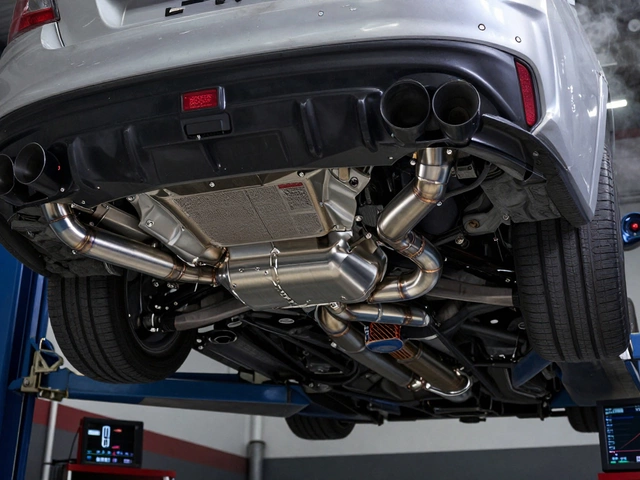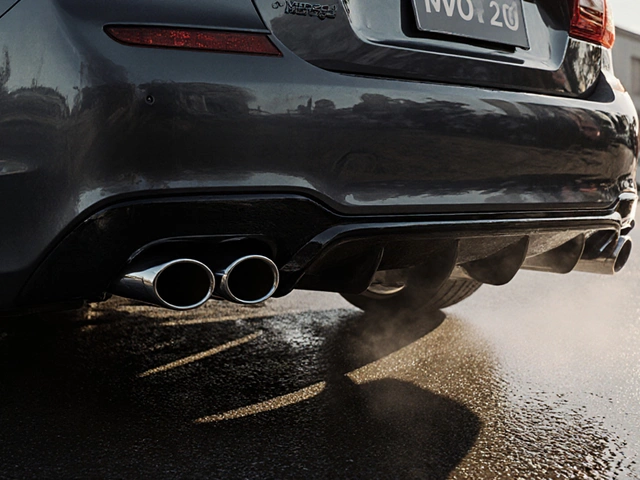Ever find yourself daydreaming about your car sounding like a beast on the prowl? You're in good company. Whether you're looking to make a statement or just want that extra thrill on the road, choosing the right muffler plays a huge role.
Let's talk muffler design first. The secret to an aggressive sound lies largely in the way a muffler is constructed. Straight-through mufflers are particularly popular for that roaring sound. They typically have a perforated tube wrapped in sound-absorbing material, which lets more sound escape. This design sacrifices a bit on the quiet ride but gives you that deep, resonant growl everyone loves.
For those curious about top picks, brands like Flowmaster and Borla often come up in conversations. These companies have nailed the design and engineering to offer a signature growl that's music to any car enthusiast's ears.
- Understanding Muffler Design
- Top Picks for Aggressive Sound
- Balancing Sound and Performance
- Installation Tips and Tricks
- Maintenance for Longevity
Understanding Muffler Design
The roar you hear isn’t just a random byproduct; it’s the result of careful muffler design. At its core, a muffler’s job is to manage and manipulate sound waves. Yet, when we're talking about aggressive sound, the design elements are more strategic.
Chambered Mufflers: Sound Control at Its Best
Chambered mufflers, like those from Flowmaster, use a series of chambers that reflect sound waves in a way that blends exhaust tones into a powerful growl. This type is pretty popular with car enthusiasts who want a traditional muscle car sound.
Straight-Through Mufflers: The Roaring Beast
Then there's the straight-through muffler design. This one's all about letting loose. It features a straight perforated pipe wrapped in sound-deadening material, minimizing back pressure and, as a bonus, boosting performance.
Turbo Mufflers: A Balance of Sound and Silence
Turbo mufflers combine elements from both chambered and straight-through designs. They’re less aggressive but still have some kick, allowing some power without going full throttle on noise.
Here's a quick look at how different designs compare:
| Type | Sound Aggression | Performance |
|---|---|---|
| Chambered | High | Moderate |
| Straight-Through | Very High | High |
| Turbo | Moderate | Moderate |
Choosing the right design really hinges on what you're after. Do you want to feel like you’re driving a track car every day? Or are you aiming for that vintage muscle car rumble? Whatever your vibe, there's a design out there just waiting to transform your car.
Top Picks for Aggressive Sound
Diving into the world of custom exhausts is like opening a treasure chest for car enthusiasts. When it comes to making that bold statement with your car's sound, these mufflers are top of the line.
Flowmaster Super 44
The Flowmaster Super 44 is often the first stop for those who crave a powerful growl. Known for its deep and aggressive tone, this muffler uses patented Delta Flow technology, ensuring you get the maximum sound without droning on the inside. If performance and sound rank high for you, this is definitely one to consider.
Borla ATAK
Next up, we have Borla's ATAK muffler. This one is all about the roar. ATAK stands for Acoustically-Tuned Applied Kinetics, a complicated way of saying it delivers one of the most aggressive sounds you can find. Those looking to turn heads with that unmistakable Borla rumble won't be disappointed. It's perfect for folks who like their presence felt several blocks away.
MagnaFlow Performance
MagnaFlow is another name that comes up frequently in the discussion about car sound. Their Performance mufflers are tailored for both sound and efficiency. While not as agressive as Borla or Flowmaster, MagnaFlow offers a more refined growl, proving that you don't always need to be the loudest to make an impact.
Choosing the Right One
Picking an aggressive muffler isn't just about decibels. You have to consider your local noise regulations and how much you're willing to invest in your car's sound system. Each muffler has its own installation nuances, so getting professional help might be a good idea, unless you're a confident DIYer. Remember, it's not just about the roar—it's about the harmony of sound and performance.

Balancing Sound and Performance
So, you've got your eyes (or ears) set on that aggressive muffler, but are you sacrificing performance? It’s a question worth thinking about. While it's tempting to go all out for sound, keep in mind that you want to maintain, or even enhance, your car's performance.
Matching sound with performance involves finding harmony between the loud roar and efficient exhaust flow. A common misconception is that louder always means better performance, which isn't necessarily true. What you want is a system that maintains optimal back pressure.
What is Back Pressure?
Back pressure refers to the resistance a muffler creates against the exhaust gases flowing out. Too much resistance can choke your engine's potential, while too little might lead to low-end torque loss.
- High back pressure: Limits engine efficiency but might help with low-speed torque.
- Low back pressure: Encourages higher horsepower but can result in torque loss at lower RPMs.
Choosing the Right Balance
To strike the right balance, consider materials and design. Stainless steel systems often provide a great combo of durability and performance. A spectral analysis by car enthusiasts has rated Borla's stainless construction as one of the top choices for durability while still delivering that aggressive car sound.
Moreover, look for a brand that offers customizable options to find a personalized setup that balances sound with performance. Some companies provide interchangeable parts specifically for achieving the precisely tuned exhaust note while retaining ample power output.
Real-World Examples
In real terms, think of high-performance cars like the Mustang Shelby GT500. It uses a high-flow exhaust system allowing for both a menacing growl and pushing out strong horsepower figures. Racers and enthusiasts continually discuss achieving such a harmonious blend, which effectively adds to the car's prowess both audibly and on the track.
Ultimately, it’s about steering your choice toward what complements your driving style and how you usually drive. If you're cruising in the city, you might want a different setup compared to someone who's often on the highway. Consulting with a custom exhaust specialist can provide insights tailored to your needs.
Installation Tips and Tricks
If you’ve settled on the perfect aggressive muffler, getting it installed right is key. Trust me, nothing's worse than a muffler that isn’t giving 100% of that sound you’re craving because it wasn’t fitted properly.
Tools of the Trade
First things first, get your tools ready. Basic hand tools like wrenches and screwdrivers are a must. An adjustable wrench and socket set will come in handy. And don’t forget your safety gear — gloves and safety glasses are non-negotiable.
Preparation Steps
Before you start, make sure your car is on a flat surface. Jack it up safely using jack stands for easy access. You'll want the exhaust system to cool down if you’ve just had a drive. Nothing like a hot exhaust to ruin your day, right?
Installation Process
- Start by removing the old muffler. Loosen clamps or bolts with your wrenches and carefully unhook the muffler from the hangers. It might be a bit rusty, so some penetrating oil can help ease this process.
- Once removed, compare the new performance muffler to ensure it matches the length and size of the old one.
- If modifications are needed (like cutting the pipe), make precise cuts and ensure the ends are smooth. Sharp edges can damage the muffler or even your car's underbody.
- Slide the new muffler onto the exhaust pipe and secure it with clamps. For better sealing, using a bit of muffler sealant at the joints isn’t a bad idea.
- Check the alignment, making sure it's symmetrical and doesn’t touch the car's body. Tighten all the clamps securely.
Testing It Out
Once everything is back in place, start the engine. Listen closely for any strange noises or leaks. Small leaks can wreak havoc on the sound quality and performance. If anything sounds off, double-check the connections and clamps.
Fun Fact
A recent survey showed that around 60% of DIY enthusiasts reported a significant boost in satisfaction after successfully installing a new muffler themselves. It’s not just about the sound, but the achievement too!
Taking your time with the install will pay off when you’re cruising and turning heads with that perfect custom exhaust note.

Maintenance for Longevity
Got yourself a custom exhaust? Awesome! Now, the key is keeping it in top-notch condition. Without regular maintenance, even the most aggressive sounding muffler can lose its edge over time. Let's dive into some solid tips to make sure your aggressive muffler keeps roaring.
Regular Inspections
A weekly or bi-weekly once-over is underrated. Check for dirt, road debris, or any unexpected dings. A small dent might not seem like a big deal, but it can mess with your exhaust sound.
Cleaning Techniques
Cleaning isn’t just for looks; it affects performance too. When it comes to cleaning your muffler, avoid harsh chemicals that could corrode. Instead, a mild soap with water or a dedicated exhaust cleaner can keep things fresh without damage.
- Step 1: Use a pressure washer or hose to remove loose dirt.
- Step 2: Apply soapy water with a microfiber cloth, especially around the joints.
- Step 3: Gently scrub any buildup.
- Step 4: Rinse well, ensuring no soap is left to dry on the surface.
Check for Leaks
Sometimes, the growl goes a bit too loud, hinting at a leak. A simple candle trick can help. Hold a lit candle near suspected joints, and if the flame flickers towards the exhaust, you might have a leak. Make sure to fix any leaks promptly for optimal performance.
Corrosion Watch
Corrosion is no friend to metal. If you live in a place with harsh winters or salty air, go an extra mile. A simple spray of anti-rust treatment after cleaning can be a lifesaver.
Professional Check-ups
Every six months, a professional check can spot issues you might miss. They’ll ensure your system’s in perfect balance, leading to both better sound and a longer lifespan.




